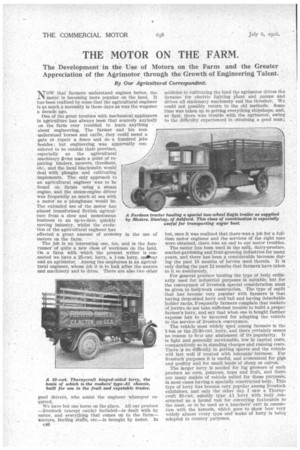THE MOTOR ON THE FARM.
Page 36

If you've noticed an error in this article please click here to report it so we can fix it.
The Development in the Use of Motors on the Farm and the Greater Appreciation of the Agrimotor , through the Growth of Engineering Talent.
By Our Agricultural Correspondent.
NOW that farmers understand engines better, the motor is becoming more popular on the land. It has been realized by some that the agricultural engineer is as much a necessity in these days as was the wagoner a decade ago.
One of the great troubles with mechanical appliances in agriculture has always been that scarcely anybody on the farm ever troubled to learn anything
about engineering. The farmer and his men -understood• horses and cattle, they could mend a gate or repair a fence and do a hundred jobs besides ; but engineering was apparently considered to be outside their province, especially as the agricultural machinery firms made a point of repairing binders, mowers, threshers, etc., and the local blacksmith would deal with ploughs and cultivating implements. The only approach to an agricultural engineer was to be found on fauns using a steam engine, and the steam-engine driver was frequently as much at sea with a motor as a ploughman would be. The extended use of the motor has almost transformed British agricul-' ture from a slow and monotonous business to an up-to-date, quickly moving industry, whilst the evolution of the agricultural engineer has effected a great amount of economy in the use of motors on the farm.
The job is an interesting one, too, and is the forerunner of quite a new class of workmen on the land. On a farm with which the present writer is connected we have a 25-cwt. lorry, a 1-ton lorry, onlikar and an agrimotor. Among the employees is an agricultural engineer, whose job it is to look after the motors and machinery and to drive. There are also two other A Fordson by Messrs.
good drivers, who assist the engineer wheneyer required.
We have but one horse on the place. All our produce —livestock (except cattle) included—is dealt with by motor, and everything that comes on to the farm— manure, feeding stuffs, etc.—is brought by motor. In c46 addition to cultivating the land the agrimotor drives the dynamo for electric lighting plant and pumps and drives all stationary machinery and the thresher. We could not possibly return to the old methods. Some time was taken up in getting everything shipshape, and, at first, there was trouble with the agrimotor, owing to the difficulty experienced in obtaining a good man ; but, once it was realized that there was a job for a fulltime motor engineer and the services of the right man were obtained, there was an end to our motor troubles.
The motor has been used in the milk, dairy-produce, market-gardening and fruit-growing industries for many years, and there has been a considerable increase during the past 18 months of lorries used therein. It is only during the past 12 months that farmers have taken to it so assiduously.
For general produce hauling the type of body ordinarily, used for industrial purposes is suitable, but for the conveyance of livestock special consideration must be given to bodywork construction. The type of outfit that has become very popular with farmers is that having drop-sided lorry and tail and having detachable ladder racks. Frequently farmers complain that makers of lorries do not take sufficient trouble to build a proper farmer's lorry, and say that when one is bought further expense has to be incurred for adapting the vehicle to the service of livestock conveyance.
The vehicle most widely used among farmers is the 1-ton or the 25-30-cwt. lorry, and there certainly seemsno reason to fe ix any abatement of its popularity. It is light and generally serviceable, low in capital costs, comparatively so in standing charges and running costs. There no difficulty in getting spares and the vehicle will laSt well if treated with tolerable fairness. For livestock purposes it is useful, and economical for pigs and poultry and for small loads of sheep or calves.
The larger lorry is needed for big growers of such produce as corn, potatoes, hops and fruit, and there are many makes of vehicle suited for these purpqses, in most eases having a specially constructed body. This type of lorry has become very popular among livestock exhibitors, and only the other day I saw a Thornycroft 30-cwt. subsidy type Al lorry with body constructed as a hound van for conveying foxhounds to the meet, or to be used as a knackers' cart in connection with the kennels, which goes to show bow very widely almost every type and make of lorry is being adapted to country purposes.
















































